Themed collection Inorganic Chemistry for Renewable Energy Conversion and Storage

Inorganic chemistry for renewable energy conversion and storage
Welcome to this Dalton Transactions themed issue entitled “Inorganic chemistry for renewable energy conversion and storage”.

Dalton Trans., 2014,43, 14924-14925
https://doi.org/10.1039/C4DT90145B
Enhanced visible light photocatalytic activity of ZnO doped with down-conversion NaSrBO3:Tb3+ phosphors
ZnO–NaSrBO3:Tb3+ composites were synthesized using microwave-assisted reaction for visible light photocatalytic degradation of methylene blue with a high degradation rate.

Dalton Trans., 2015,44, 97-103
https://doi.org/10.1039/C4DT01252F
Long afterglow Sr4Al14O25:Eu,Dy phosphors as both scattering and down converting layer for CdS quantum dot-sensitized solar cells
Long afterglow Sr4Al14O25:Eu,Dy phosphors were used on top of a transparent TiO2 layer for CdS QDSSCs with enhanced photovoltaic performance.
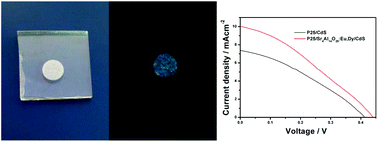
Dalton Trans., 2014,43, 14936-14941
https://doi.org/10.1039/C4DT01276C
A functionalized, ethynyl-decorated, tetracobalt(III) cubane molecular catalyst for photoinduced water oxidation
A new tetracobalt(III)-oxo cubane 1 was prepared. The ethynyl groups do not affect the photocatalytic properties of 1, which, in contrast, appear to be improved.
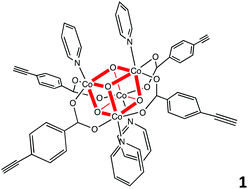
Dalton Trans., 2014,43, 14926-14930
https://doi.org/10.1039/C4DT01785D
Porous nitrogen-doped carbon microspheres as anode materials for lithium ion batteries
Porous nitrogen-doped carbon microspheres, synthesized via a microwave-assisted method and thermal treatment, exhibit excellent electrochemical performance for lithium ion batteries.
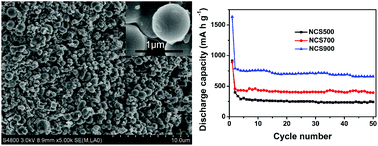
Dalton Trans., 2014,43, 14931-14935
https://doi.org/10.1039/C4DT01223B
Thermoelectric properties of higher manganese silicide/multi-walled carbon nanotube composites
Significant thermal diffusivity reduction in HMS/MWCNT composites prepared by ball milling and spark plasma sintering.
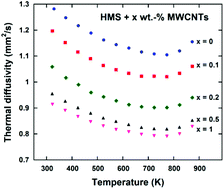
Dalton Trans., 2014,43, 15092-15097
https://doi.org/10.1039/C4DT01441C
Branched and bulky substituted ruthenium sensitizers for dye-sensitized solar cells
Four novel Ru(II)-sensitizers (TT206–209) incorporating two different types of branched and bulky alkyl chains, were tested in TiO2-DSSCs.
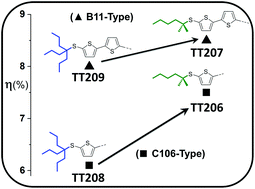
Dalton Trans., 2014,43, 15085-15091
https://doi.org/10.1039/C4DT01357C
In situ powder X-ray diffraction study of the hydro-thermal formation of LiMn2O4 nanocrystallites
The reaction details for hydrothermal synthesis of LiMn2O4 nanocrystallites is revealed through in situ X-ray powder diffraction studies.
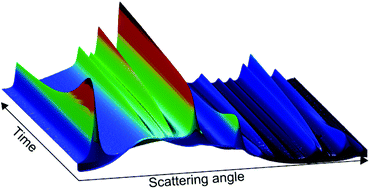
Dalton Trans., 2014,43, 15075-15084
https://doi.org/10.1039/C4DT01307G
Ultraslow recombination in AOT-capped TiO2 nanoparticles sensitized by protoporphyrin IX
Electron transfer from an excited PPIX dye to the conduction band of surfactant capped TiO2.

Dalton Trans., 2014,43, 15065-15074
https://doi.org/10.1039/C4DT01926A
Proton conductivity of hexagonal and cubic BaTi1−xScxO3−δ (0.1 ≤ x ≤ 0.8)
Scandium substituted BaTiO3 reveals hexagonal and cubic structures, and the proton conductivity is several orders higher in the cubic materials.

Dalton Trans., 2014,43, 15055-15064
https://doi.org/10.1039/C4DT01280A
Mechanistic insights into electrocatalytic CO2 reduction within [RuII(tpy)(NN)X]n+ architectures
Modifying the electron density within a RuII-polypyridyl molecular architecture via electron-donating/withdrawing character of the bidentate ligand set has provided insight into the electronic requirements for catalytic CO2 reduction.
![Graphical abstract: Mechanistic insights into electrocatalytic CO2 reduction within [RuII(tpy)(NN)X]n+ architectures](/en/Image/Get?imageInfo.ImageType=GA&imageInfo.ImageIdentifier.ManuscriptID=C4DT01591F&imageInfo.ImageIdentifier.Year=2014)
Dalton Trans., 2014,43, 15028-15037
https://doi.org/10.1039/C4DT01591F
A novel perovskite based catalyst with high selectivity and activity for partial oxidation of methane for fuel cell applications
The introduction of nickel into a strontium zirconate perovskite converts the reforming characteristics from one of limited activity and total oxidation to one of high activity and selectivity for partial oxidation.

Dalton Trans., 2014,43, 15022-15027
https://doi.org/10.1039/C4DT01288G
Assembly, characterization, and electrochemical properties of immobilized metal bipyridyl complexes on silicon(111) surfaces
Mixed methyl/bipyridyl-functionalized silicon surfaces have been prepared, and subsequently modified to form metal complexes on the surface.

Dalton Trans., 2014,43, 15004-15012
https://doi.org/10.1039/C4DT01149J
The origin of the n-type behavior in rare earth borocarbide Y1−xB28.5C4
It was revealed that boron carbide inclusions were the origin of the p-type behavior in the Seebeck coefficient α previously observed for Y1−xB28.5C4 in contrast to Y1−xB15.5CN and Y1−xB22C2N, the long awaited n-type counterparts to boron carbide. Calculations show a pseudo gap-like structure in density of states and importance of the borocarbonitride network.

Dalton Trans., 2014,43, 15048-15054
https://doi.org/10.1039/C4DT01303D
Cobalt orthosilicate as a new electrode material for secondary lithium-ion batteries
Co2SiO4 is investigated for the first time as lithium-ion active material and a lithium storage mechanism is proposed including the reversible formation of Li4SiO4.
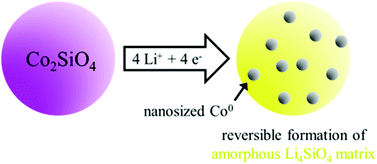
Dalton Trans., 2014,43, 15013-15021
https://doi.org/10.1039/C4DT01325E
Novel 4′-functionalized 4,4′′-dicarboxyterpyridine ligands for ruthenium complexes: near-IR sensitization in dye sensitized solar cells
Five novel ruthenium sensitizers, MC113–MC117 were synthesized and applied for dye sensitized solar cells.
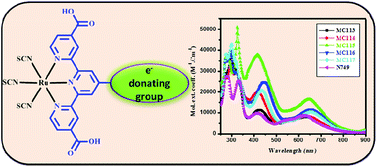
Dalton Trans., 2014,43, 14992-15003
https://doi.org/10.1039/C4DT01598C
A first-principles investigation of oxygen reduction reaction catalysis capabilities of As decorated defect graphene
Arsenic adsorbed double vacancy defect graphene systems are found to demonstrate excellent electrocatalytic properties for oxygen reduction reaction via high affinity towards four electron process.
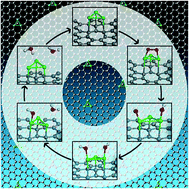
Dalton Trans., 2014,43, 15038-15047
https://doi.org/10.1039/C4DT01258E
Well-controlled metal co-catalysts synthesised by chemical vapour impregnation for photocatalytic hydrogen production and water purification
Engineered fine metal nanoparticles prepared by chemical vapour impregnation method improve the photocatalytic performance of titanium dioxide.
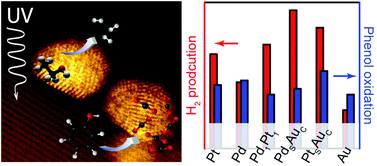
Dalton Trans., 2014,43, 14976-14982
https://doi.org/10.1039/C4DT01309C
Sb- and Bi-doped Mg2Si: location of the dopants, micro- and nanostructures, electronic structures and thermoelectric properties
Doping Mg2Si with Bi leads to a partial replacement of the Si atoms with Bi and an accumulation of Bi between the grain boundaries, both causing enhanced zT values.
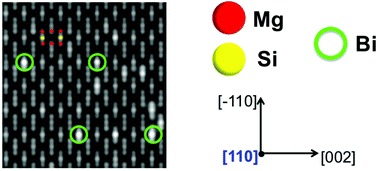
Dalton Trans., 2014,43, 14983-14991
https://doi.org/10.1039/C4DT01177E
Annealing effects on the properties of BFe2As2 (B = Ca, Sr, Ba) superconducting parents
Thermal annealing results in ∼6 K shifts in the structural and magnetic transition temperatures of BaFe2As2 and SrFe2As2.

Dalton Trans., 2014,43, 14971-14975
https://doi.org/10.1039/C4DT01068J
Structural and thermodynamic similarities of phases in the Li–Tt (Tt = Si, Ge) systems: redetermination of the lithium-rich side of the Li–Ge phase diagram and crystal structures of Li17Si4.0−xGex for x = 2.3, 3.1, 3.5, and 4 as well as Li4.1Ge
Li17Ge4 was established as the lithium-richest and Li4.10Ge as a high-temperature phase in the revised Li-rich section of the Li–Ge phase diagram (>79 at% Li).
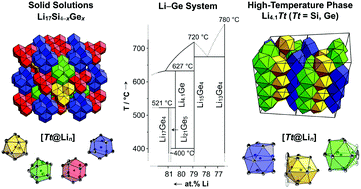
Dalton Trans., 2014,43, 14959-14970
https://doi.org/10.1039/C4DT00743C
TOF-SIMS characterization of impurity enrichment and redistribution in solid oxide electrolysis cells during operation
TOF-SIMS was used to investigate the enrichment and redistribution of impurities in solid oxide cells during operation.
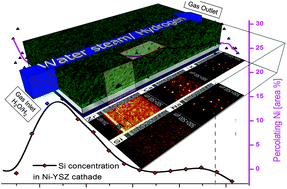
Dalton Trans., 2014,43, 14949-14958
https://doi.org/10.1039/C4DT01053A
Photoreduction and light-induced triplet-state formation in a single-site fluoroalkylated zinc phthalocyanine
Anaerobic red-light illumination leads to reduction of perfluoroisopropyl-substituted zinc(II) phthalocyanine in ethanol, while low power UV illumination favours the formation of a triplet excited state.
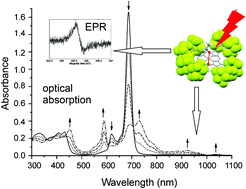
Dalton Trans., 2014,43, 14942-14948
https://doi.org/10.1039/C4DT00621F
About this collection
This issue, guest edited by Professor Lars Kloo (KTH Royal Institute of Technology), showcases recent developments in all aspects of inorganic/organometallic materials and coordination chemistry of relevance for the conversion and storage of renewable energy